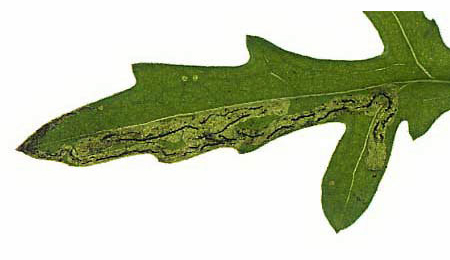|
||||||
|
Liriomyza
centaureae Hering, 1927 Liriomyza
centaureae Hering, 1927c. Z. angew. Ent. 13:
182 |
|||||||||||||||||||||||||||||||||||||||||||||||||||||||||||||||||||||||||||||||||||||||||||||||||||||||||||||||||||||||||||||||||||||||||||||||||||||
Leaf-miner: A short irregular linear mine with frass in more or less connected threads (Spencer, 1976: 238). Fairly long, upper-surface, little branched corridor; loops close together. Frass in pearl chains or strings. Pupation outside the mine (Bladmineerders van Europa).
Larva: The larvae of flies are leg-less maggots without a head capsule (see examples). They never have thoracic or abdominal legs. They do not have chewing mouthparts, although they do have a characteristic cephalo-pharyngeal skeleton (see examples), usually visible internally through the body wall. The larva is described by de Meijere (1937: 199, as Liriomyza sp. on Centaurea jacea); posterior spiracles each with 8-10 bulbs (Spencer, 1976: 238). Puparium: The puparia of flies are formed within the hardened last larval skin or puparium and as a result sheaths enclosing head appendages, wings and legs are not visible externally (see examples). Yellow (Paklaniskis, 1994a). Hosts in Great Britain and Ireland:
Hosts elsewhere:
Time of year - mines: June-October. Time of year - adults: Currently unknown. Distribution in Great Britain and Ireland: Widespread in Britain including Surrey (Box Hill), Middlesex (Scratch Wood), Buckinghamshire (nr Tring), Cambridge (Chippenham Fen), Glam (Cefn Rhigos), Denbighshire (Cefn-y-bedd), Aberdeen (Den of Pitlurgh), Sutherland (Loch Assynt) (Spencer, 1972b: 55), Warwickshire (Kingsbury) (Robbins, 1991: 122); Anglesey, Cambridgeshire, East Gloucestershire, South-west Yorkshire and Stafford (NBN Atlas). Distribution elsewhere: Common and widespread in much of Europe, including Denmark, Norway, Sweden (Spencer, 1976: 238), The Netherlands, Luxembourg (Bladmineerders van Europa), Germany (Spencer, 1976: 558), Estonia, European Turkey, French mainland, Hungary, Italian mainland, Lithuania, Poland, Slovakia and Spanish mainland (Fauna Europaea). NBN Atlas links to known host species:
British and Irish Parasitoids in Britain and elsewhere:
|
|
|
|
| External links: | Search the internet: |
| Biodiversity Heritage Library Bladmineerders van Europa British leafminers Encyclopedia of Life Fauna Europaea NBN Atlas NHM UK Checklist |
Find
using Google Find using Google Scholar Find images using Google |
| Last updated 09-Jul-2019 Brian Pitkin | ||

